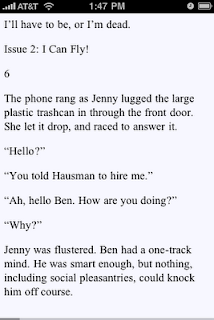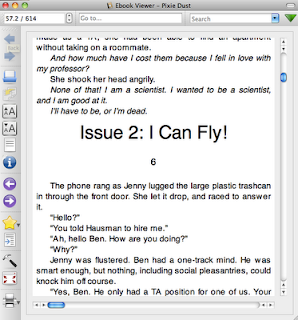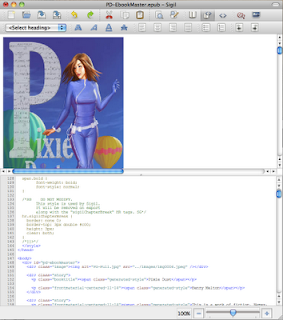At the end of the previous post, I had a functional ePub file of the novel Pixie Dust. Unfortunately, when I open the file in Adobe’s Digital Editions, calibre, and iPhone’s Stanza I quickly see numerous formatting errors, despite my preparation. Well, I was expecting this. Let’s get to the next step, making corrections to the ePub file.
The first, sad, realization is that the various ebook display software engines will do different things with the same source file. At this point in history, I just have to accept it. But it is really sad that Stanza doesn’t highlight a chapter title, center anything, or even show italics.
All that I can change is the source code. What needs to be fixed? At this stage, there is an error in the Table of Contents. After the novel, there is a little bit of advertising for my other books. The conversion picked up a couple of items there and added it to the table of contents. The other obvious correction is that a new chapter does not start on a new page. While this is minor with the properly displayed large chapter title, on Stanza, I paged right past it the first time. Making it harder for a reader to navigate around in the book is bad if I can avoid it. Lastly, the cover isn’t centered. Perhaps I should have fixed it in the InDesign version, and I will, but I can also fix it in the ePub.
Sigil is an open source ePub editor, that allows both HTML coding and WYSIWYG editing in an optional two pane environment. It also has a metadata editor for title, author, etc. and a table of contents editor.
To fix the cover centering, just click, click in the upper pane and the code is fixed.
For hands-on HTML coding, you use the lower pane and play with the HTML and CSS to your heart’s content. For example, the copyright information did not shrink in size like I wanted it to, but by adding a font-size: 50% in the CSS for the style of that front material, even if the user changes font size to their preference, this material will be smaller and less obnoxious. Likewise, the bogus TOC entries proved to be incorrect use of styled types in the advertising section. Changing the HTML to correct the styles removes that problem.
Unfortunately, I often see rendering flaws in Sigil, like the example here, where part of a sentence is skipped, even though it is correct in the source code and shows fine in the other book reader software. It’s just something to be cautious about, but Sigil’s advantages are definitely worth using.
So, with some HTML and CSS coding, the end result looks a lot closer to the e-book I would like to present to the world. However, after this pass through Sigil, the Table of Contents information supplied by InDesign has been lost. Perhaps this is an expected result, but it has happened to me with all previous uses of Sigil, and so I psych myself up to regenerate the Table of Contents using Sigil’s own TOC tool.
Using the WYSIWYG mode, I visit each chapter title (called ‘Issue’ in this novel) and Insert Chapter Break (second icon from the right on the top row) just before “Issue”. Then I use the Select headings=”” pulldown to set the code to Heading 2. Finally, just in case, I apply center formatting to the chapter title. Repeat for each place I wish to start on a new page.
The Chapter Break marks places to start on a new page. Sigil’s TOC generator seems to use only the Heading tags to generate its entries (vs a more flexible system in InDesign)
There is also a Metadata editor, which would have been useful to correct a character in the description field, but proved difficult to edit-in-place. I had to copy the text to an external editor, change the curved-single quote to a straight apostrophe, delete the description field and the re-add it using copy and paste.
The calibre ebook conversion system also has metadata editing, and is much easier to use, however calibre sucks the files into it’s own library and is difficult for such in-place changes. When you save to file, it exports a directory tree with the file name changed to its structure.
But that’s it for this task. I’ll rename the file to something more public and begin to use the converted file. If this write up about the process seems a bit disorganized, you are a perceptive person.





